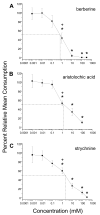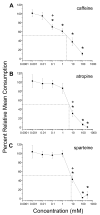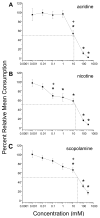The effect of varying alkaloid concentrations on the feeding behavior of gypsy moth larvae, Lymantria dispar (L.) (Lepidoptera: Lymantriidae)
- PMID: 21278814
- PMCID: PMC3027075
- DOI: 10.1007/s11829-008-9035-6
The effect of varying alkaloid concentrations on the feeding behavior of gypsy moth larvae, Lymantria dispar (L.) (Lepidoptera: Lymantriidae)
Abstract
Nine alkaloids (acridine, aristolochic acid, atropine, berberine, caffeine, nicotine, scopolamine, sparteine, and strychnine) were evaluated as feeding deterrents for gypsy moth larvae (Lymantria dispar (L.); Lepidoptera: Lymantriidae). Our aim was to determine and compare the taste threshold concentrations, as well as the ED(50) values, of the nine alkaloids to determine their potency as feeding deterrents. The alkaloids were applied to disks cut from red oak leaves (Quercus rubra) (L.), a plant species highly favored by larvae of this polyphagous insect species. We used two-choice feeding bioassays to test a broad range of biologically relevant alkaloid concentrations spanning five logarithmetic steps. We observed increasing feeding deterrent responses for all the alkaloids tested and found that the alkaloids tested exhibited different deterrency threshold concentrations ranging from 0.1 mM to 10 mM. In conclusion, it appears that this generalist insect species bears a relatively high sensitivity to these alkaloids, which confirms behavioral observations that it avoids foliage containing alkaloids. Berberine and aristolochic acid were found to have the lowest ED(50) values and were the most potent antifeedants.
Figures



References
-
- Ahmad S, Forgash AJ. NADPH-cytochrome-c-reductase: changes in specific activity in gypsy moth larvae. Journal of Insect Physiology. 1975;21:85–88. - PubMed
-
- Appel HM, Maines LW. The influence of host plant on gut conditions of gypsy moth (Lymantria dispar) caterpillars. Journal of Insect Physiology. 1995;41:241–246.
-
- Barbosa P, Krischik VA. Influence of alkaloids on feeding preference of eastern deciduous forest trees by the gypsy moth Lymantria dispar. American Naturalist. 1987;130:53–69.
-
- Barbosa P, Gross P, Provan GJ, Pacheco DY, Stermitz FR. Allelochemicals in foliage of unfavored tree hosts of the gypsy moth, Lymantria dispar L. 1. Alkaloids and other components of Lirodendron tulipifera L. (Magnoliaceae), Acer rubrum L. (Aceraceae), and Cornus florida L. (Cornaceae) Journal of Chemical Ecology. 1990;16:1719–1730. - PubMed
-
- Bernays EA, Chapman RF. Deterrent chemicals as a basis of oliphagy in Locusta migratoria (L.) Ecological Entomology. 1977;2:1–18.
Grants and funding
LinkOut - more resources
Full Text Sources
